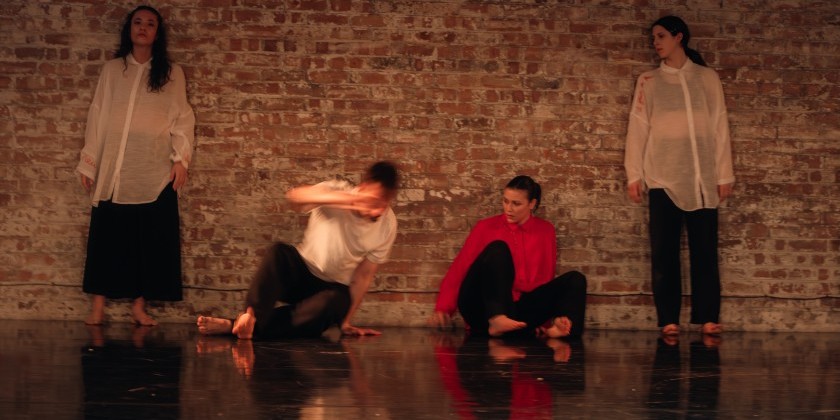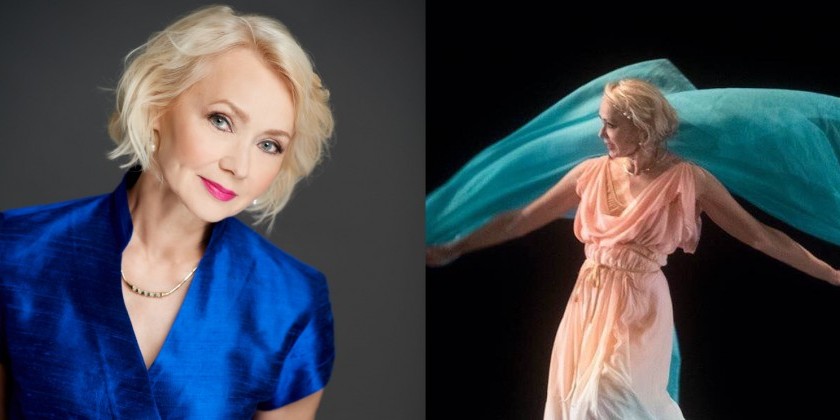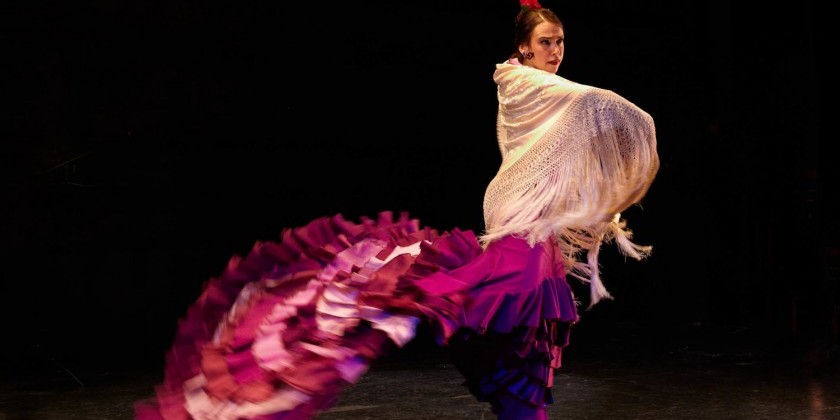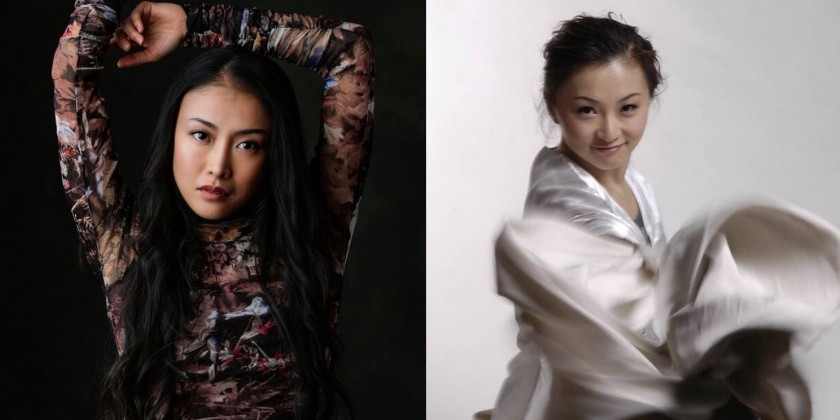Curator Denise Greber And Puppeteers Duda Paiva And Chad Williams On The 8th La MaMa Puppet Festival

The 8th La MaMa Puppet Festival
November 1-25, 2018
Tickets: http://lamama.org/puppet_festival/
Duda Paiva & Nancy Black's BLIND // November 8 - 11, 2018
WonderSpark Puppets' Chicken Soup, Chicken Soup // November 17 - 18, 2018
Since 1962, the La MaMa Puppet Festival showcases new contemporary puppet theatre by artists from around the world. Curated by Denise Greber, this year’s series focuses on diversifying the voices, stories, and perspectives shared onstage, with the goal of uplifting marginalized identities within the puppet community. The festival highlights interdisciplinary works from female artists who explore issues such as cultural identity, Black Lives Matter, the refugee crisis, and the disability experience.
Sammi Lim for The Dance Enthusiast: Oh boy, I know there isn't really a way to quantify this, but what do you love most about theatre?
Denise Greber, Curator of La MaMa's Puppet Festival and Member of Loco7 Theatre Company: I love the magic of live theatre. When it is done well, it is an incredibly exciting place to be. You see something in that moment and know that it may happen again the next night, but not exactly the same. It reminds me to be present in life and engage here and now.
How has the festival evolved over time?
Denise Greber: This is actually the 8th La MaMa Puppet Festival, as the festival started in 2004. We have skipped a year (give or take) these past 14 years. The change is that little by little it is expanding; we've added a program here and there to give more opportunities for artists to perform at La MaMa.

FOOD FOR THE GODS, a multimedia performance installation about “human value" inspired by the killings of black men. Photo © Nehprii Amenii.
Have your selections also changed massively? Do you look out for different things nowadays or have your criteria remained consistent?
Denise Greber: As a curator it is not always good to just present what you love and what you like to see as an audience member. There are some pieces that I really love and connect with, others that I feel are important to bring to the stage for their topics, and then again others because I feel the potential of the artist and their need to present a work. That has been steady in the programming over the years, something I learned from Ellen Stewart, La MaMa’s Founder.
Do you believe that puppetry, much like comedy, can be a 'stealth' way to address sensitive issues?
Denise Greber: Absolutely. It is a unique art form that allows for the audience to engage with the objects/puppets in a way that we are not always able to with humans. There is something distinct about what we, as an audience, project on to an inanimate object.

I’d like to address a topic I’ve seen floating around on social media channels: non-consensual audience participation. BLIND, which addresses disability, rejection and resolution, sees a high volume of audience interaction. How do you know when to push it farther or whether to draw back?
Puppeteer Duda Paiva: Disability, rejection, and resolution are manifested in different ways and sometimes they are manifested internally. The performance BLIND is designed to accommodate spontaneous reactions both from public as well as from the performer. Some of audience members are invited to sit on stage, more precisely on chairs on the sides. The show begins as if the audience are part of the script; they are all in a waiting room, expecting the arrival of a doctor who, apparently, will help all those in need.
Each performance differs concerning the triangulation between performer/ audiences. All interactions vary from show to show, this reality forces the actor to develop a flexible performing mode that celebrates spontaneity and generosity, wit and air amongst people.
Puppeteers, in addition to performing, often hone an additional skill: the creation of their props, puppets, or stage personas. How did you go about it? By attending a college course? By seeking out a mentor?
Duda Paiva: I attended extensive lessons on classic ballet, contemporary dance, Butoh and drama in private institutions both in Brazil, Japan, and Holland. It was in Holland that my attention bent towards the art of puppetry. All I learned about the art of puppetry, including acting/manipulation and sculpting came from Neville Tranter (Dutch-Australian) and the Gertrude Theater (Israeli), my first experimentations were kindly supported by both dance and puppetry Dutch 'production houses.'
In the beginning of 2004, Duda Paiva Company was formally created. We make visual theatre that combines dance, new media and puppets (I call them moving-sculptures). DPC moving-sculptures are made out of supple foam and carved using sharp objects. They are designed and made by myself as well as other sculptors such as DPC's head sculptor Andre Mello. The material foam inspires and maximizes my physical and mental activities, forcing me to think out of the box owing to its flexibility and vast range of metamorphosis, not only in a mask's expression but in the whole body too.

How does your dance background lend itself to puppetry?
Duda Paiva: Dance and puppetry have many similar requirements such as rhythm, precision, focus, and spatial awareness, but they can be utter antagonists too. To bring a puppet to life it needs a reason, it needs to be justified, whereas dance doesn't. Dance can be perceived in a total different way both by whom does the moves and who watches it. Abstract versus Storytelling. I love both. Both guide me to learn from the differences and there is a moment that both disciplines give support to the existence of each other, instead of undermining, nor killing, its organic potentialities.
What, in your opinion, makes a good puppet act?
Duda Paiva: The 'self-learning' trait of many puppet groups worldwide makes puppetry a special art form because each moving-sculpture is unique! Sometimes a whole new technique is born to handle a specific character (for example: How to manipulate a knee puppet? How to manipulate a non-string or rod puppet?) This uniqueness is rich to me; it's freedom. Creation obeys no rules.
But I understood, through the years, that there was a lack of preparation and physical awareness for those who want to blend disciplines. Questions started to pop out such as: How can I prepare my own body? How can I be fluid with ideas and still be able to transport them to another body (puppet)? How can I make a manipulation seem believable? How do I blend different skills together?
Therefore I created The Object Score — a methodology for the physical puppeteer. Talent is important but technique can open doors that we never thought possible. To end my answer, the most important for a good puppet act is 'the audience.' Puppets are needy; they need the audience to tell them that they are alive. The pure affirmation that they are alive is what keeps them from dying.
Aren’t they inanimate objects after all?

Chicken Soup, Chicken Soup. Photo © WonderSpark Puppets.
Chicken Soup, Chicken Soup is the puppet show I wish to see most, as I too, have grandmothers from different backgrounds. In our increasingly globalized world, it's certainly has strong appeal. Did you approach children’s author Pamela Mayer to turn her book into a play, or was it the other way round?
Chad Williams, Co-founder of WonderSpark Puppets: Chicken Soup, Chicken Soup was born of a grant from PJ Library to The 14th Street Y Theater to develop new works based on their books. They are a wonderful organization that gives free books with Jewish themes to kids all over the country. We had turned the book 'Beautiful Yetta: The Yiddish Chicken' by Daniel and Jill Pinkwater into a hand puppet show in 2016 (presented by the 14th Street Y), and were given the freedom to pick a PJ Library book in 2017 to do the same. The theater obtained permission from the publisher, and we had about 6 months to turn a 5-minute story into a full-length play.
We chose Chicken Soup, Chicken Soup for a multitude of reasons. It has a great story with themes that we really love, with an all-female cast of varying ages. Secondly, the book has two specific pages where each grandmother plays with Sophie —- but what they do is ambiguous and literally anything could be there. We used those two moments to expand upon the story, giving each grandmother time to try and win Sophie over with stories from their own culture. The competition between the two women is more unspoken in the original book, but it gives us a great motive to justify their over-the-top actions in our puppet show. Also, any excuse to bring the Monkey King into a story is a good one :)
My wife Z literally based the Jewish Grandmother on her own. Like the character in the book, she loved to cook and passed on that love (and recipes) to Z when she was a little girl.

Jewish-Chinese grandmothers in Chicken Soup, Chicken Soup. Photo © WonderSpark Puppets.
How do you inject quirks or motor tics into a character? My guess is by observing real-life characters?
Chad Williams: I take inspiration from Taiwanese puppet theater. They use a stock cast of archetypes, like Commedia dell'arte, so as soon as an actor steps onto stage, the costume, movement, voice, and such are immediately understood by the audience as, "Oh, it's that one." There's a lot of room for nuance and imbuing each character with your own personal memories, but that's where I generally start. In a puppet play, the puppeteer is allowed to perform more than one character (or all of them!). Perfecting the details for each character, how they move, how their voice sounds, how they relate to each other, is something that can take a long time but enhances the illusion. Playing with the characters once they are built can help add to the script and fill any unseen plot holes.
What qualities, in your opinion, do the best puppeteers possess?
Chad Williams: Puppeteers are cousins to magicians in that we all put on a grand illusion. If the puppeteer does their job properly, the audience will forget the technical aspects of what they are seeing ("I know it's not real!") and buy in that these inanimate objects are actually alive. Children immediately focus on puppets and believe. It can take adults a little bit longer. The art form is unique in that we as actors can perform as tiny ants or massive giants, as men or women or animals or whatever on an unlimited scale. In Chicken Soup, Chicken Soup, Z performs over 10 different characters that include old women, little children, vegetable princesses, wooden spoons, and a talking oven mitt. Through these puppets she is able to communicate to the audience the message of the story, a celebration of foods, cultures, and the art of storytelling.
The Dance Enthusiast Asks Questions and Creates Conversation.
For more of The Dance Enthusiast Asks, click here.
Share your #AudienceReview of this performance or others for a chance to win a prize.














